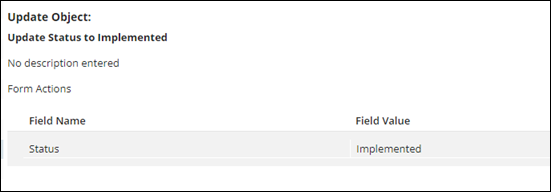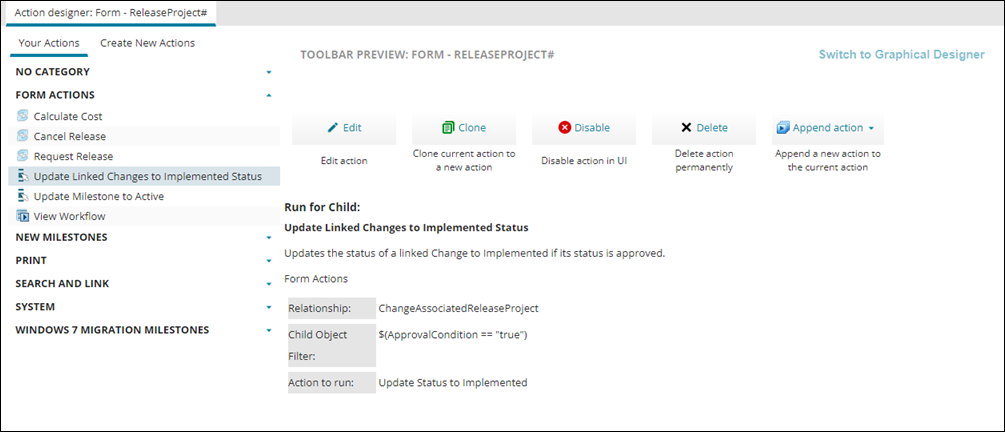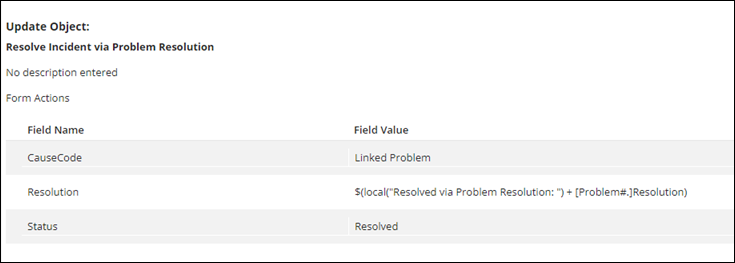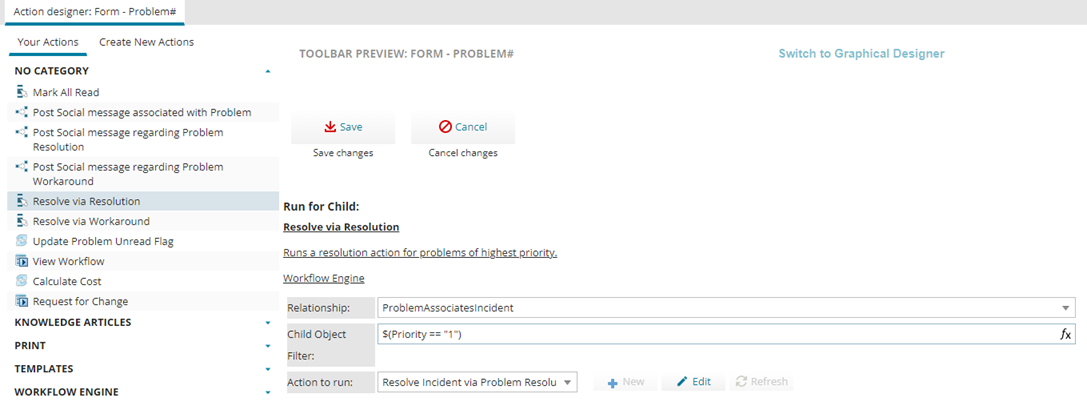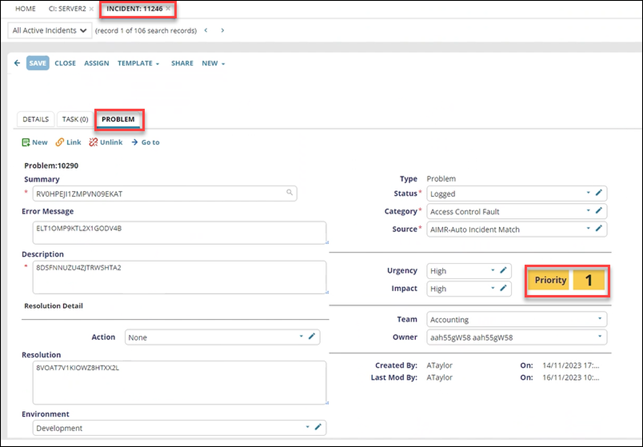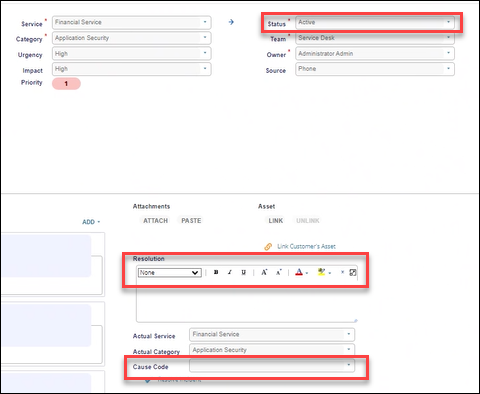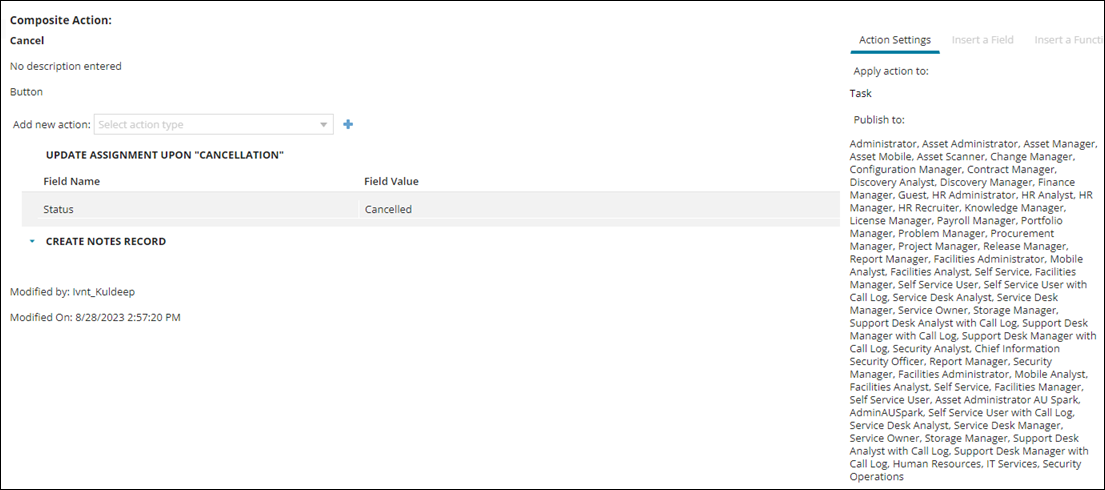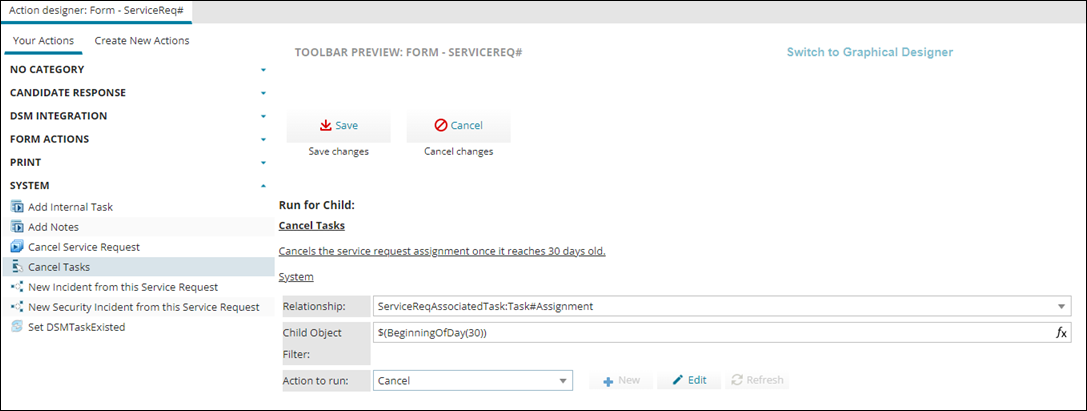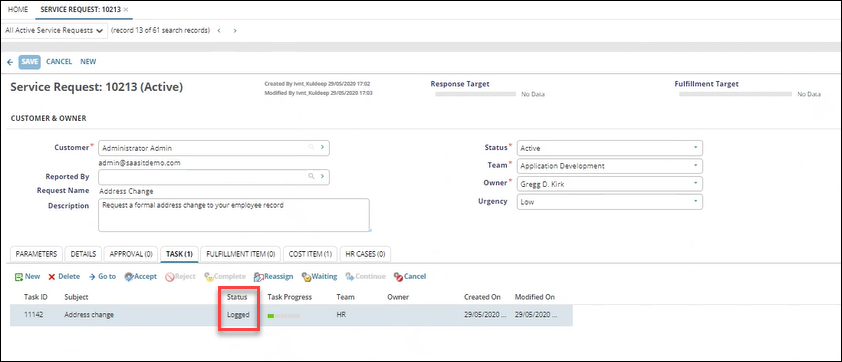Example: Using the Run for Child Action (CAD)
Use the Run for Child action to perform an action on a child business object of a parent business object. See Run for Child Action.
•Example using the Release (ReleaseProject) Business Object
•Example using the Problem Business Object
•Example using the Service Request Business Object
Prerequisites
This example assumes you have administrator-level access to ITSM and are familiar with creating both business objects and Quick Actions.
How to create a Run for Child Quick Action
To create a Run For Child Quick Action:
1.From the Configuration console, click Build > Automation Tools > Quick Actions to open the Actions Manager workspace. The list of business objects that have actions appears.
2.Select a business object from the list and click Add/Edit.
3.In the Actions Center, click the Create New Actions tab.
4.Under the Create New Actions tab, click Run for Child.
5.Enter your parameters in the fields provided. Examples of business objects and their parameters are shown in the tables below.
6.Click Save.
Example using the Release (ReleaseProject) Business Object
Scenario
A company has a number of change records linked to a Release business object. They want to use IvantiNeurons for ITSM to update the status of these changes (RFCs) in a batch to the Implemented status. By leveraging the Run for Child Quick Action, the company can easily set up a way to update these associated "child" records in Neurons for ITSM.
| Field | Parameter |
|---|---|
| Enter action name | Update Linked Changes to Implemented Status |
| Enter action description | Updates the status of a linked change to Implemented if its status is approved. |
| Enter category |
Form actions Choose a category to place your new action in the Your Actions tab on the left of the screen. OOTB category options include No Category, Form Actions, New Milestones, Print, Search and Link, System or Windows 7 Migration Milestones. To create your own category, type a name instead of selecting from the Category drop-down list. |
| Relationship | ChangeAssociatedReleaseProject |
| Child Object Filter |
$(ApprovalCondition == "true") This means that the action only runs on change records where the field ApprovalCondition is true. |
| Action to run |
Update Status to Implemented This action is set up as follows: It sets the change record's Status field to Implemented. |
Run the Scenario
1.Log in as a Change Manager.
2.Create a new Change with Type Emergency.
3.Run the Update Status to Implemented Quick Action.
The Status field is set to Implemented, and if the Approvals and Approval Vote Tracking tabs do not exist yet, they are created.
Example using the Problem Business Object
Scenario
A company has a number of problems linked to an associated incident business object. They want to use IvantiNeurons for ITSM to update the status of these records in a batch so that all problems at Priority 1 are set to status Resolved.
| Field | Parameter |
|---|---|
| Enter action name | Resolve via Resolution |
| Enter action description | Runs a resolution action for problems of highest priority. |
| Enter category | Workflow Engine The selected category determines where your new action appears in the Your Actions tab on the left of the screen. Choose from No Category, Knowledge Articles, Print, Templates or Workflow Engine OOTB categories. The Workflow Engine category helps group actions related to altering the path of records through the system. To create your own category, type a name instead of selecting from the Category drop-down list. |
| Relationship | ProblemAssociatesIncident |
| Child Object Filter | $(Priority == "1") |
| Action to run | Resolve Incident via Problem Resolution This action is set up as follows: It sets the Incident record's Cause Code field to Linked Problem, the Resolution field to Resolved via Problem Resolution, and the Status field to Resolved. |
Run the Scenario for a Single Record
1.Login as an Administrator.
2.Open the Incident workspace and select an Incident with an associated Problem at Priority 1 or create one.
Increasing the values for Urgency and Impact fields gives you a Priority 1.
The Resolution, Cause Code and Status fields at the bottom of the Problem are set to None, Blank and Active respectively:
3.Click on More > Form Actions > Resolve Via Resolution.
4.When the Resolve via Resolution Quick Action is run, the three fields are updated to Resolved via Problem Resolution, Linked Problem, and Resolved respectively.
Example using the Service Request Business Object
Scenario
A company has a number of task records linked to the Service Request business object. They want to use IvantiNeurons for ITSM to update the status of these records in a batch so that once the task reaches 30 days old, its Status gets sets to Cancelled.
| Field | Parameter |
|---|---|
| Enter action name | Cancel Tasks |
| Enter action description | Cancels the service request assignment once it reaches 30 days old. |
| Enter category | System The category chosen sets the location for your new action in the Your Actions tab on the left of the screen. Choose from No Category, Button, Escalation Engine or Mobile OOTB categories. To create your own category, type a name instead of selecting from the Category drop-down list. |
| Relationship | ServiceReqAssocTaskAssignment |
| Child Object Filter | $(BeginningOfDay(30)) |
| Action to run | Cancel This action is set up as follows: It sets the Task record's Status field to Cancelled. |
Run the Scenario
1.Log in as an Administrator.
2.Open the Service Request workspace and select a record with associated tasks that are older than 30 days. If you cannot find tasks of that age, modify the Child Object filter value in the Quick Action to a lower number, such as 5 days, for testing the action.
3.Check that the Status field is not set to Cancelled already.
4.Click on More > System > Cancel Tasks.
5.Enter a Reason for Cancellation when prompted.
6.When the Cancel Tasks Quick Action has been run, the Status field is updated to Cancelled.
